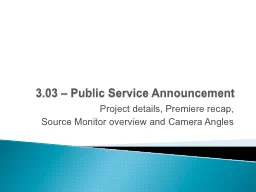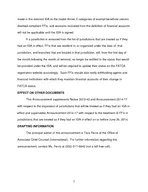PPT-3.03 – Public Service Announcement
Author : myesha-ticknor | Published Date : 2016-03-03
Project details Premiere recap Source Monitor overview and Camera Angles Key Concepts PSA Guidelines Setting up your Folders Source Monitor MarkIn MarkOut The Fourth
Presentation Embed Code
Download Presentation
Download Presentation The PPT/PDF document "3.03 – Public Service Announcement" is the property of its rightful owner. Permission is granted to download and print the materials on this website for personal, non-commercial use only, and to display it on your personal computer provided you do not modify the materials and that you retain all copyright notices contained in the materials. By downloading content from our website, you accept the terms of this agreement.
3.03 – Public Service Announcement: Transcript
Download Rules Of Document
"3.03 – Public Service Announcement"The content belongs to its owner. You may download and print it for personal use, without modification, and keep all copyright notices. By downloading, you agree to these terms.
Related Documents














